Typhoon Haiyan: Philippines Destruction 'Absolute Bedlam'
By BBC
11 November, 2013
BBC
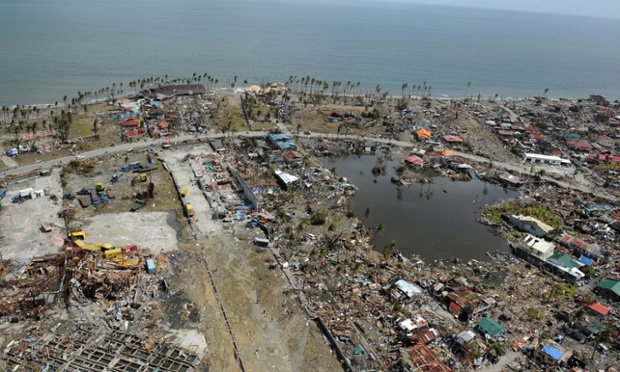
Destroyed houses in the city of Tacloban, Leyte province. (Photograph: TED ALJIBE/AFP/Getty Images)
The head of the Red Cross in the Philippines has described the devastation caused by Typhoon Haiyan as "absolute bedlam".
Officials estimate up to 10,000 people have died in Tacloban city and elsewhere. Hundreds of thousands of people are displaced.
Rescue efforts are being hindered by damage to roads and airports.
The storm has now made landfall in north Vietnam, near the Chinese border, but has weakened to a tropical storm.
One of the most powerful storms on record to make landfall, Haiyan - named "Yolanda" by Filipino authorities - barrelled into the eastern coastal provinces of Leyte and Samar on Friday.
It then headed west, sweeping through six central Philippine islands.
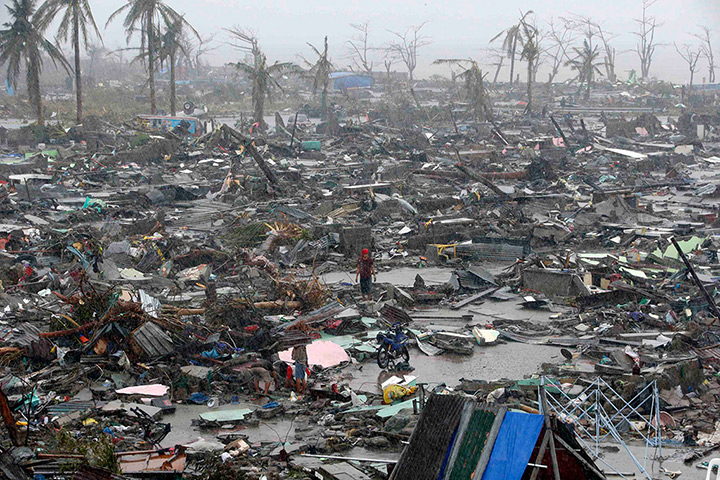
People stand among debris and ruins of houses destroyed after typhoon Haiyan battered Tacloban city. (Photo: Reuters)
Supplies
More than nine million people have been affected in the Philippines. Many are now struggling to survive without food, shelter or clean drinking water.
A picture is slowly emerging of the full damage wrought by the storm:
The exposed easterly town of Guiuan, Samar province - population 40,000 - is said to be largely destroyed
Tacloban, Leyte province, was largely flattened by a massive storm surge and scores of corpses are piled by the roadside, leaving a stench in the air as they rot, say correspondents. Hundreds of people have gathered at the airport desperate for food and water, others trying to get a flight out
Disaster worker Dennis Chong told the BBC that assessments in the far north of Cebu province had shown some towns had suffered "80-90% damage"
Baco, a city of 35,000 in Oriental Mindoro province, was 80% under water, the UN said
A huge international relief effort is under way, but rescue workers have struggled to reach some towns and villages cut off since the storm.
"There's an awful lot of casualties, a lot of people dead all over the place, a lot of destruction," Richard Gordon, head of the Philippine Red Cross, told the BBC.
"It's absolute bedlam right now, but hopefully it will turn out better as more and more supplies get into the area."
"The situation is bad: the devastation has been significant. In some cases the devastation has been total," Secretary to the Cabinet Rene Almendras told a news conference.
Mr Gordon said roads had now been cleared to allow relief workers to get to some of the hardest hit areas, but that they expected to find many more casualties.
"It's only now that they were able to get in and we're beginning just to bring in the necessary food items... as well as water and other things that they need."
Forecasters predicted a tropical depression would move into the south and central Philippines on Tuesday, potentially bringing heavy rains that would further hamper relief efforts.
Jane Cocking, the humanitarian director for Oxfam, said her colleagues witnessed "complete devastation... entire parts of the coastline just disappeared, and sizable trees just bent over and [were] thrown about like matchsticks."
A Philippine military spokesman was quoted as saying on Monday that 942 people had died in the typhoon's aftermath, though it is clear the official death toll will rise significantly.
Almost 630,000 people have been reported displaced.
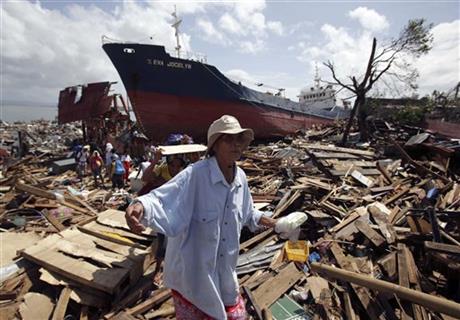
Survivors walk through the rubble of damaged homes and a ship that was washed ashore in Tacloban city, Leyte province, central Philippines on Sunday, Nov. 10, 2013. The city remains littered with debris from damaged homes as many complain of shortages of food and water and no electricity since Typhoon Haiyan slammed into their province. Haiyan, one of the most powerful storms on record, slammed into six central Philippine islands on Friday, leaving a wide swath of destruction and scores of people dead. (AP Photo/Aaron Favila)
'Unprecedented' storm
Some are questioning what more authorities could have done to prepare for this, just the latest in a string of disasters to hit the nation of more than 7,000 islands.
Authorities had evacuated hundreds of thousands of people before the typhoon arrived, but many evacuation centres - schools, churches and government buildings - proved unable to withstand the winds and storm surges.
Many survivors in stricken areas heeded official urgings to stockpile supplies - but found that they were washed away along with the rest of their possessions.
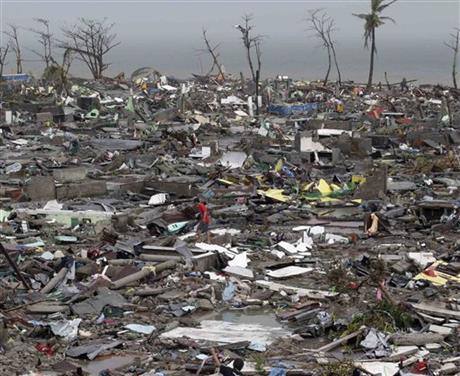
Destroyed houses lie in Tacloban city, Leyte province, central Philippines on Sunday, Nov. 10, 2013. The city remains littered with debris from damaged homes as many complain of shortages of food and water and no electricity since Typhoon Haiyan slammed into their province. Haiyan, one of the most powerful storms on record, slammed into six central Philippine islands on Friday, leaving a wide swath of destruction and scores of people dead. (AP Photo/Bullit Marquez)
Haiyan brought sustained winds of 235km/h (147mph), with gusts of 275 km/h (170 mph), with waves as high as 15m (45ft), bringing up to 400mm (15.75 inches) of rain in places.
"The world has not seen a storm like this before," said Senen Mangalile, the Philippines Consul General to the UK.
Steven Godby, a disaster management expert at Nottingham Trent University, told the BBC the typhoon was "probably the most intense and strongest storm of this type to make landfall".
"We've seen storms like this perhaps on rare occasions that have had that kind of intensity out at sea but for it to come ashore with that kind of strength is almost unprecedented," Dr Godby said.
Officials said looting was widespread and order was proving difficult to enforce, but correspondents say many ordinary people are simply scavenging for the food and water needed to survive.
Hundreds of soldiers have been deployed to try to restore order in Tacloban, but one resident told AFP that people were becoming violent out of desperation.
"I am afraid that in one week, people will be killing from hunger," secondary school teacher Andrew Pomeda, 36, said on Sunday.
Philippine President Benigno Aquino said there was a possibility that martial law or a state of emergency would be declared in the city.
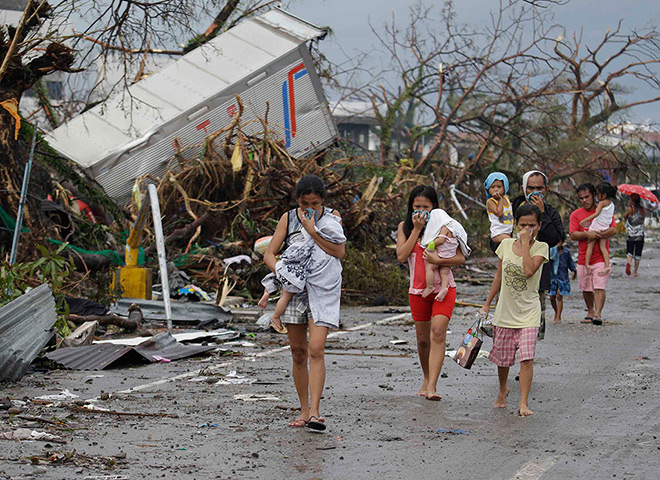
Residents cover their noses as they walk near dead bodies. (Photograph: Bullit Marquez/AP)
In some areas, the dead are being buried in mass graves.
American military aircraft and ships are being deployed to provide help. Aid is being flown into the only regional international airport at Cebu, with relief efforts focusing on Tacloban.
US President Barack Obama has issued a message saying he was "deeply saddened by the loss of life and extensive damage".
Other countries have also pledged millions of dollars in assistance. Australia has approved $9m in humanitarian aid to the Philippines, while New Zealand has pledged over $1m.
Kristalina Georgieva, the EU humanitarian aid commissioner, said relief efforts would be guided by three priorities: to establish access, then offer immediate aid, then shelter.
Typhoon Haiyan has now made landfall in Vietnam, near the tourist destination of Ha Long Bay, with sustained winds of up to 140 km/h (85mph).
Some 600,000 people were evacuated in northern provinces of the country.
Comments are moderated
